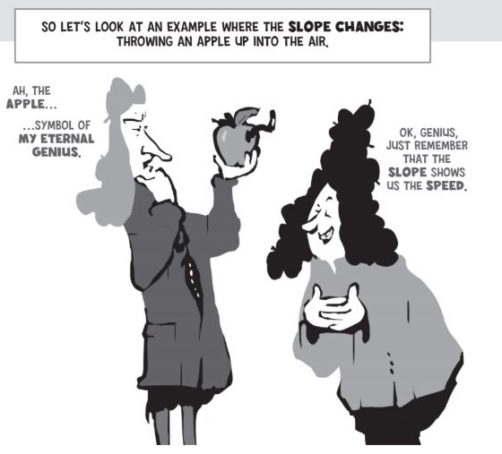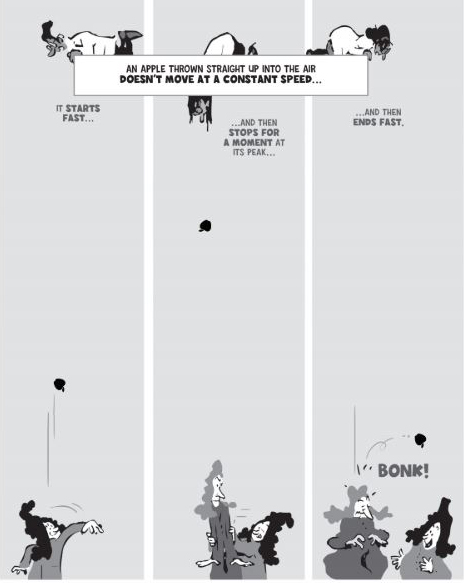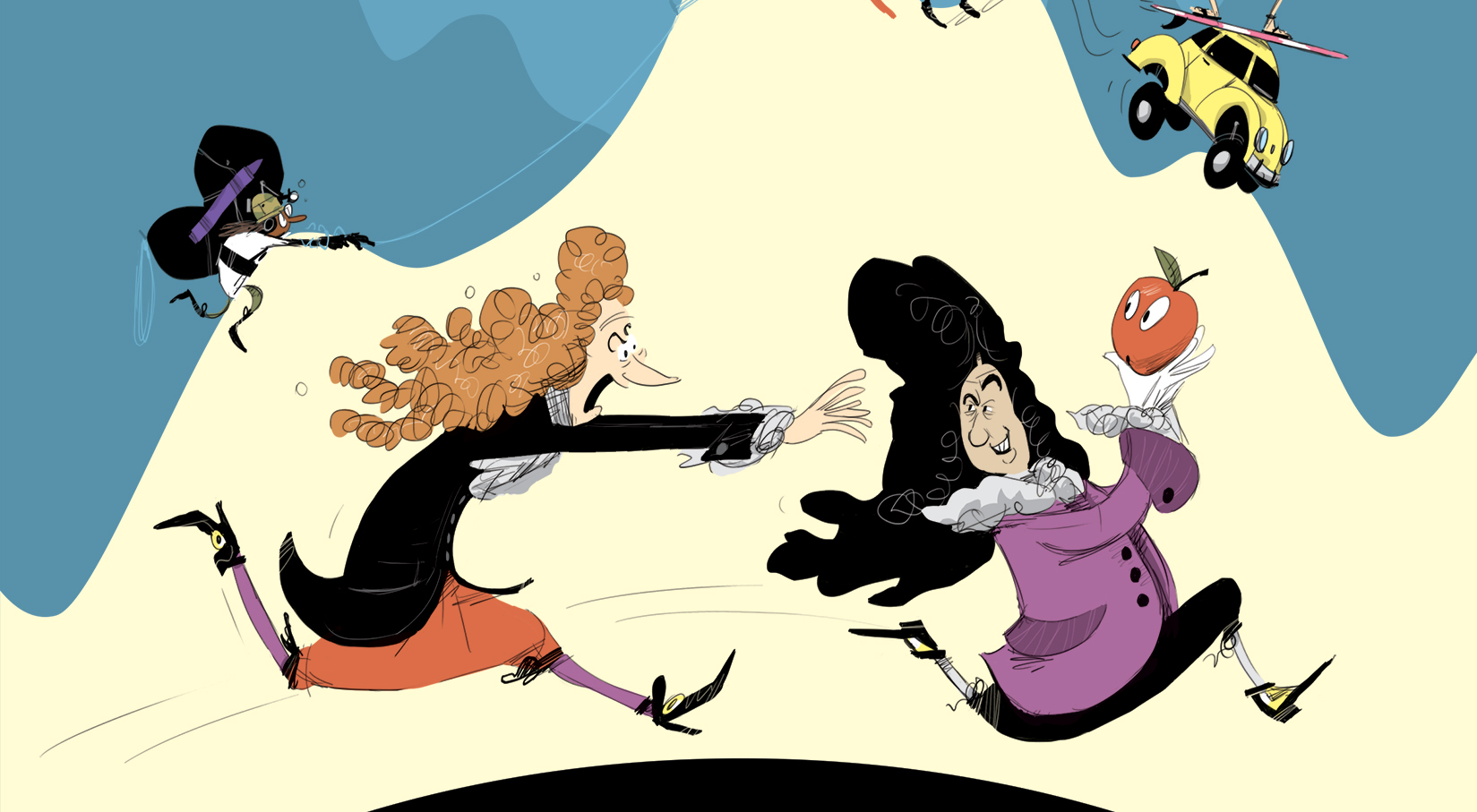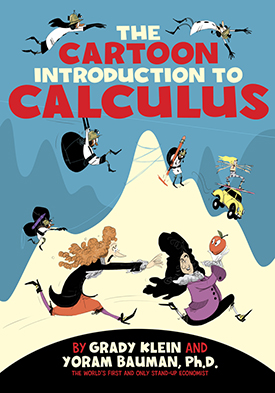Grady Klein and Yoram Bauman are the co-authors of The Cartoon Introduction to Calculus. They collaborated previously on the two-volume Cartoon Introduction to Economics, on The Cartoon Introduction to Climate Change, and on a pamphlet called The Cartoon Introduction to Digital Ethics.
Yoram Bauman: Congratulations Grady, we’ve made it to the finish line of Cartoon Calculus!
Grady Klein: I’ll drink to that! Do you think this book was harder than our previous books?
Bauman: In and of itself, no. But external circumstances were more demanding: I was working on a carbon tax ballot measure campaign in Washington State in 2015–2016, so that took up a lot of time. Plus taking care of Child #2, and of course Child #1, neither of whom existed back when we started collaborating. Ten years ago, right?
Klein: Eleven. (But who’s counting!) We’re definitely in the “old married couple” stage of our relationship. I can tell when you’re going to come after me for using a hyphen instead of an em dash!
Bauman: What’s funny is that we know each other so well even though we’ve only met in person maybe three or four times. Occasionally we have awkward phone conversations, too, but mostly we do everything by email.
Klein: Yes, we met once when Thomas LeBien (a former FSG editor) set us up on a “blind date” to see if we could work well together. That was book #1, Cartoon Microeconomics.
Bauman: Yup. Thomas saw one of my YouTube videos (Principles of Economics, Translated, now with over 1 million hits) and asked me if I was interested in working on a cartoon book about economics. I said yes and he introduced me to a couple of different potential co-authors/illustrators. You and I hit it off…and the rest is history!
Klein: Yes, although we’ve never done a Cartoon History book. Why is that?
Bauman: For one thing, Larry Gonick’s Cartoon History of the Universe is out there. For another, neither of us are subject matter experts. You’ve done books (like Cartoon Statistics) with other co-authors, but I try to limit myself to things I know a lot about: economics, climate change, and calculus. My first academic love…
Klein: Calculus?

Bauman: Well, mathematics more generally. I was an undergraduate math major, at Reed College in Portland, Oregon. I thought about going to math graduate school but decided against it. But I got far enough to read Baby Rudin, the first in a series of in-depth books by Walter Rudin.
Klein: Perhaps our book qualifies as something like “fetus Rubin”? Or “zygote Rubin”?
Bauman: Hah! But the truth is that I barely get that joke. You’ll have to do Cartoon Biology with somebody else.
Klein: Not a bad idea, especially now that we have a solid process for writing these books. You create a first-draft script, and then we bat it back and forth for a while, tightening up the language and the dialog, adding jokes, smoothing over rough spots…
Bauman: It’s especially helpful to have you bring a “beginner’s mind” perspective that can identify parts that go too fast or are too confusing.
Klein: …and then when we’re happy with the script I mock it up in my drawing program, just with the text boxes and dialog boxes so we can see how it looks on the page. That’s the second part of the process. And then the third part is where I lock myself in the attic and draw.
Bauman: And I try to leave you alone.
Klein: Much appreciated. Drawing with a mouse isn’t easy.
Bauman: And making changes is hard. That’s one of the interesting features of cartoon books: doing the final artwork is really time-intensive, so we have to work hard to make sure the structure and text are solid first. Each of those three parts you mention takes a minimum of six months.
Klein: Or, in the case of this book, much more! I think that’s one thing that makes our books different: the text and artwork are tightly integrated. It’s not just a textbook with some drawings thrown in on top of it.
The fundamental unit of cartoon books is not the paragraph or the page but the two-page spread
Bauman: Indeed. And that was definitely a challenge for me to adapt to when we started. The fundamental unit of cartoon books is not the paragraph or the page but the two-page spread: how does the book look when you open it up?
Klein: And that’s why there are features of the book that may not be immediately apparent to the reader. For example, each chapter in our books has either 10, 12, or 14 pages. That’s so they all “seem” about the same length and so they all start on a right-hand-side page and end on a left-hand side page. That consistency is important for making readers comfortable, so they can concentrate on the content.

Bauman: Speaking of content, our goal here was really to write a book about calculus for folks who aren’t super excited about math. It covers the big picture ideas and aims to motivate readers to go deeper with other textbooks, materials on the web…
Klein: Baby Rudin.
Bauman: Exactly. And with a cartoon book you can spend an entire chapter on an idea, like limits, by making and drawing analogies. That’s the sort of thing that can get lost in a 600-page textbook.
Klein: Our joke is that students will spend $200 on a textbook that they’ll have trouble opening, and then $20 on our cartoon book, and that’s what they’ll learn from.
Bauman: People often laugh when I tell them that we’ve written a cartoon book about calculus. Does that happen to you?
Klein: Oh, yes. I think that’s because people think that cartoon books are “just for kids.” But that’s totally not true.
Bauman: My standard answer to that is to observe that safety instruction cards on airplanes are written as cartoons, not as paragraphs of text. And it’s not because they’re “just for kids”…although it is true that my five-year-old has me read and re-read the safety card to her every time we’re on a plane!
Klein: Speaking of safety, this book was different from our previous books because it very clearly contained one frame that was way more difficult to complete than any of the others, and it was because it that frame touched on a torrentially unsafe combination of topics.
Bauman: Turns out that a frame dealing with mathematics, women, the Greek system, and ideas of “beauty” raises lots of red flags. Who would have guessed? But the frame started out as a totally innocuous idea: there’s a mathematical concept known as an epsilon-delta proof of continuity, and so the basic idea was to have a few college students representing different sororities—delta gammas, etc.—and then one of those sororities would be called epsilon delta.
Klein: And it ended up innocuously enough as well, at least I hope so! But the iterations in between were challenging, both with the text and with the images.
Bauman: Our editors definitely earned their keep with that one. And I want to give a shout-out to my DG friend Anja for helping, too. They all seem happy with the final version.
Klein: And we hope all our readers are happy with it too. Let us know!
A freelance cartoonist, illustrator, and animator, Grady Klein is the creator of the Lost Colony series of graphic novels.
An environmental economist at the University of Washington, Yoram Bauman, Ph.D., is the world’s first and only stand-up economist.
They are the coauthors of The Cartoon Introduction to Economics, volumes one and two.

